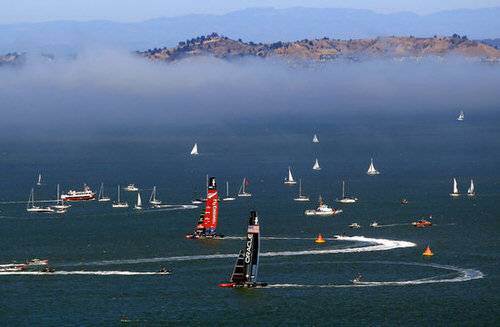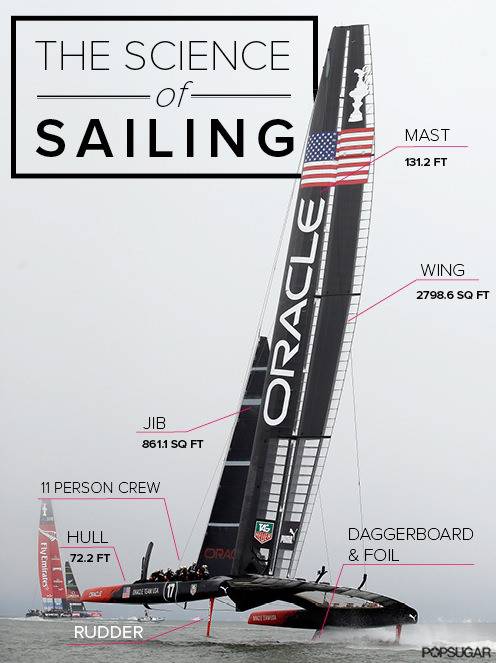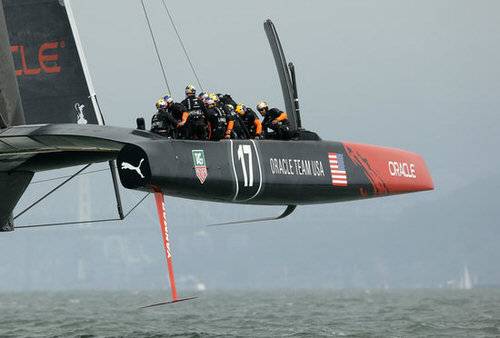

Editor’s note: This post was originally published by our partners at PopSugar Tech.
A brand-new boat, the AC72, is hitting the water for the 34th America’s Cup, an intense race between two sailing yachts that dates back to 1851. The new 131-foot-tall (that’s 13 stories!), 72-foot-long catamaran is designed to be the most powerful sailing machine in the world—and, consequently, is the most dangerous.
We saw this massive specimen of the sea in all its glory at the America’s Cup Finals in San Francisco (which may run through Sept. 21), courtesy of Lexus, and were in awe of the boat’s size, speed, and beauty. Watching Team USA and Team New Zealand zip through the bay’s relentless changing winds and negotiate tight, sharp turns revealed the precise physics and athleticism required to operate these fast, water-faring vehicles. So we proceeded to investigate the science of sailing.
The sport of sailing demands great skill and a deep understanding of wind, currents, and physics. The sailors of Oracle Team USA and Emirates Team New Zealand put on a great show, with both boats neck and neck for the most of the race and ending with the Kiwis’ eventual victory. Each 11-person crew must tack (zigzagging the boat while sailing against the wind), steer, and maintain balance all the way to the finish while running back and forth between the boat’s two hulls.
Foiling is the technique most synonymous with racing and involves suspending the catamaran’s hulls above the water while balancing on a pair of L-shaped boards. The art of foiling can increase the boat’s speed and reduce drag significantly—but it’s also incredibly risky. In May, Team Sweden crashed its AC72 during a practice run, causing the death of one crew member, and in October 2012, Team USA capsized its catamaran, but, fortunately, no one was injured in the incident.

Sailing is far from child’s play and involves a great deal of teamwork between skilled tacticians. Take a closer look at the colossal AC72 and the materials that make this sailing machine glide across the water.
Essential Stats
- Weight — 6.5 tons
- Hull length —72.2 feet
- Maximum beam — 45.9 feet
- Mast height — 131.2 feet
- Maximum draft — 14.4 feet
- Displacement — 5,900 kg
- Wing area — 2798.6 square feet
- Jib area — 861.1 square feet
- Gennaker area — 3,444.5 square feet
- Crew — 11 people

Materials and Components
- Titanium — This metal can be found through the AC72, since it has one of the highest strength-to-weight ratios among metals. It’s also very resistant to corrosion, making it an ideal choice for the salt-water-faring sailing machines.
- Carbon fiber — Threads of carbon fiber, a strong and lightweight material, are woven together to create a cloth-like fabric. An epoxy resin is heated, and pressure is applied, forming the base laminate (the rigid structure) of the woven carbon fiber.
- Honeycomb — A honeycomb pattern material is applied to curved surfaces. It’s made of either aluminum or Nomex insulation paper and has a high strength-to-weight ratio.
- Carbon fiber composite — Two materials are combined to create a sandwich structure, a method used in aircraft and spacecraft construction as well.
- Crew — Each member of a team’s 11-person crew is equipped with padded body armor, a flotation device, and a crash helmet. For safety purposes, sailors also carry an emergency oxygen tank, a knife, personal location devices, and an electronic headcount unit.
- Electronic sensors — Placed throughout the boat, the sensors collect different data, including strain, pressure, and vertical and lateral loads on every major component. The sailors themselves wear sensors that monitor vitals such as heart rate. An AC72 can have over 300 sensors on board.
Watch video from the Exploratorium’s exhibit at America’s Cup on the @popsugartech Instagram page! We explore how wind affects the sea’s currents, the ship after which America’s Cup is named, and how to control a boat’s sail.
Images courtesy of Getty
More stories from PopSugar Tech:
The Final Frontier: Voyager 1 Reaches Interstellar Space
8 Trips Around the World With Google Maps Street View
What to Do When Your Computer Freezes
5 Steps to Get the Highest iPhone Resale Value
Apple Product Launch Day: A GIF Guide to All of the Feels

















